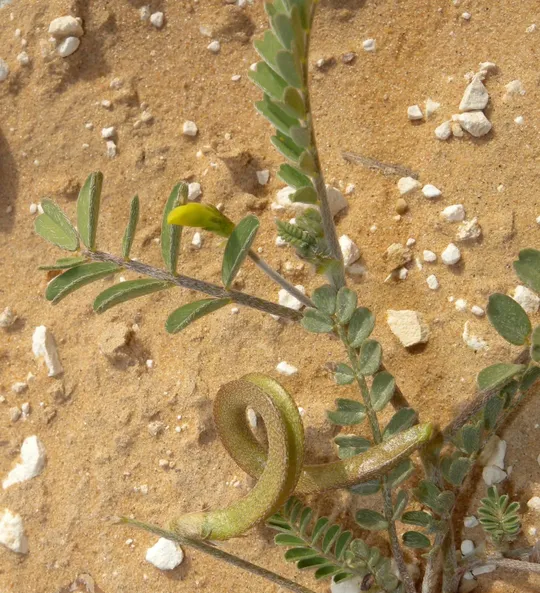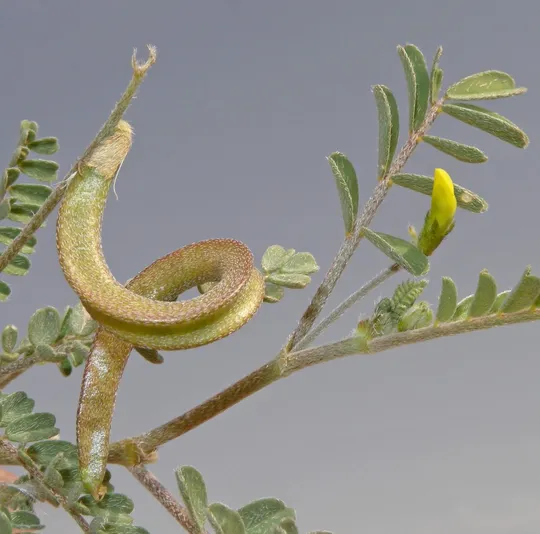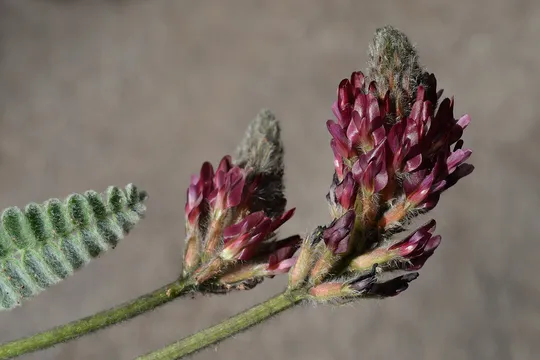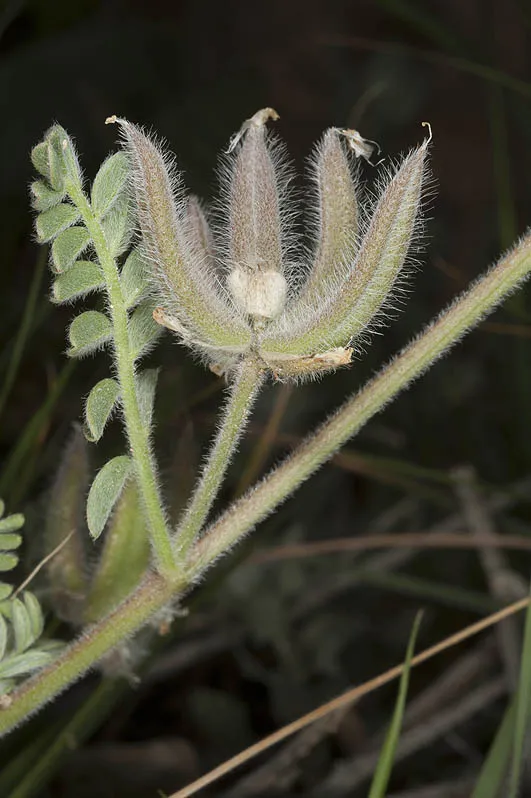Egyptian Milk-vetch
Astragalus trimestris


Astragalus trimestris grows in the
northern Negev and the Arava on seven sites, but it is estimated that there are
about a dozen sites in Israel. In the northern Negev it is found on the western
Negev sands, south of Tse’elim, in the Revivim sands and in Kerem Shalom. It disappeared
from the area of Magen and Wadi HaBsor. It is also found in the sands of the Yamin
Plain. In the Arava it grows in the Hatzeva-Shezaf area. There are reports that
A.
trimestris was once collected and observed in Pleshet in the
Petah Tikva area, but is now extinct there.
Sandy expanses in the desert and coast. Astragalus
trimestris grows together with Retama raetam and Moltkiopsis
ciliata in the western Negev.
The genus Astragalus has about 2000 species and according
to some scientists the genus includes about 3000 different species. Some separate
it from the Papilionaceae family and afford it,
together with several close genera, the status of a separate family – the
Astragalaceae. Astragalus is one of the largest genera
in the world and includes annuals, herbaceous perennials, dwarf shrubs and
shrubs found throughout the world except for Australia. The genus speciation
center is in desert areas and cold arid steppes in the Irano-Turanian region in
Central Asia and Iran. The genus has a characteristic large papillionate flower
(7-20 mm) and elongated odd-pinnately compound
leaves and lacks tendrils (unlike Vicia and Lathyrus).
Its pod structure distinguishes Astragalus from
most of the Papilionaceae genera. In most of the Papilionaceae
during dispersal, the two pod valves dehisce (open) along their
dorsal and ventral seam (on which the seeds sit) at once, curl and fling the
seeds tens of centimeters away. In Astragalus, the pod does not open,
but detaches completely from the plant or remains dry and attached to the plant
for many years. The fruit in the genus Astragalus is divided lengthwise
by an imaginary partition that divides the pod into two chambers, each of which
has a row of seeds. The seeds are arched when young and have different shapes
during ripening from a sphere, a lens to a cube. The fertile pod serves as a
seed dispersal mechanism. In some species of Astragalus the fruit dehisces
along its dorsal seam gradually, from the pod base to its top, and the seeds distribute
their germination over a number of years, under different germination
conditions.
For the global and local distribution of Astragalus
species – see A. oocephalus.
A. trimestris
belongs to the section Harpilobus, whose species have an inflorescence
borne on an axillary peduncle, and a campanulate calyx. There are several
species in this section in Israel: A. arpilobus
characterized by a small number of broad leaflets and limited to the extreme
desert; A. intercedens
with a crescent shaped pod and compressed hairs, characteristic of the extreme
desert from the Dead Sea to Elat; A. callichrous,
which forms purple carpets in the transition zone and the northern Negev; A. hispidulus, with narrow ring-like fruit and
modest flowers, found in the northern Negev and the Negev Highlands, and A. eremophilus
found only in the Elat region and the southern Arava, with pinkish
flowers and soft hairs on all its parts.
·
Astragalus trimestris survived in only two of the three regions in which it was collected
or observed, and is extinct in Pleshet. The number of sites in the northern
Negev appears to be declining and the species is now extinct in the Magen area and
in Wadi HaBsor near Tel Re’im (Jemmeh). The latest observations and collections
are from the late 1980s and it is unclear if A. trimestris exists in all the sites today.
·
Urban and
agricultural development probably led to the extinction of A. trimestris populations in Pleshet and the Bsor and Magen area. Damage to sandy
areas from military exercises in Tse'elim-Revivim is endangering the plant in
this area.
·
A. trimestris
is protected in the Wadi Shezaf Nature
Reserve
·
There is a lack
of information on the threat status of A. trimestris
in Egypt and Libya.
The sites where Astragalus trimestris was documented
in the northern Negev and Arava should be surveyed to confirm
the survival of these populations and to find other sites. Long-term monitoring
will allow the study of A. trimestris population dynamics and
characterization of propagation methods in the field and in refuge gardens.
Astragalus trimestris grows in southern
Israel, Sinai, Egypt and Libya.
Astragalus
trimestris
is a rare annual plant of desert sands, about which not much is known.
According to available documentation, there has been a substantial decline in
the number of regions and sites in which it grows. Existing sites may be threatened by military
activity as well. The main distribution of A. trimestris is south of Israel
and the Israeli sites are located at the northern edge of its range.
Current Occupancy Map
| 1000 squre meter pixel | 5000 squre meter pixel | 10000 squre meter pixel | |
|---|---|---|---|
| number of observations | 0 | 0 | 0 |
| in total pixels | 0 | 0 | 0 |
| Family | Fabaceae |
| Classification | On the endangered species list |
| Ecosystem | Desert |
| Chorotype | Saharo – Arab (Mediterranean) |
| Conservation Site | Shezaf Sands |
| Rarity |
1
3
6
|
|---|---|
| Vulnerability |
0
2
4
|
| Attractiveness |
0
0
4
|
| Endemism |
0
0
4
|
| Red number |
1
3.2
10
|
| Peripherality | S |
| IUCN category | DD EW EX LC CR EN VU NT |
| Threat Definition according to the red book | Vulnerable |
 Based on:
Based on:






